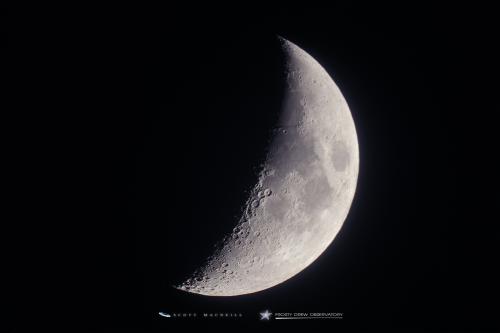Phases of the Moon
Do you remember your science teacher's explanation of the phases of the Moon? My fifth grade teacher pulled the blinds down tightly, turned on a spotlight and we all watched as she carried a gray ball around us. Sure enough, we could see the light illuminate different areas of the globe simulating the monthly changes we saw on the Moon. Today I do much the same thing on the Internet so that www.frostydrew.org image of the Moon reflects the phase for the following Friday. The example we have here is a 35% waxing Moon.
The mathematical function which describes what part of the Moon is illuminated and what part is darkened is a function we learn in high school trigonometry classes. This function is called the cosine [often noted as cos on hand held calculators]. I'm not going to spend the whole article doing mathematics but I do want to make a point. In high school I found trigonometry to be boring beyond endurance. I still don't care how many preposterous ways I can measure the height of a building. One height calculation was sufficient - the other endless repetitions merely caused my mind to wander.
Never once in that high school trigonometry course was I exposed to the cosine as a tool for understanding astronomy, navigation or alternating electric currents. My fifth grade teacher made the phase of the Moon interesting and memorable. My high school teacher really missed an opportunity to use the Moon's phase to make cosines fascinating. I understand that teachers avoid real world applications beyond their students. However tough applications can be demonstrated without making them part of the final examination. This excites kids rather than stupefying them.
Oh, by the way, the formula for determining the Moon's illuminated area is simply ½(1-cos M) where M is the number of degrees between the Moon and the Sun. M turns out to be pretty close to the number of days since the New Moon times 12.2. So our 35% illuminated waxing Moon occurs almost 6 days into the lunar month.
A very rare skimming transit of Mercury occurs on November 15th. Transits are mini-solar eclipses where a tiny planetary disc rather than a large lunar disc passes between the Sun and us. Only Mercury and Venus ever transit. Usually they either pass above or below the Sun on their ways to and from the morning and evening skies. Mercury has passed between us and the Sun only 13 times this century. This transit is really special because Mercury just skims the limb of the Sun. In North America, western South America and the Pacific, Mercury will appear completely inside the Solar disc. In southern Australia, Mercury will skim across the Solar disc half in and half out. The rest of the world will miss everything. This type of skimming transit is very rare. After November, another such occurrence won't happen for almost four centuries.
We won't get very much time to see this spectacle, because it will start just a few minutes before Sunset. If you want to view this event, use proper eye protection. Even a few minutes of direct sunlight can damage your eyes forever. Projected images are safest. Mercury, the edge of the Sun and Charlestown RI first line up at 4:12PM. They stay lined up for almost an hour until 5:11PM. Unfortunately, at 4:24 PM, both the Sun and Mercury will set, ending the transit for us. Folks in the central and western US will be better placed to see the whole show.
I hope you'll come over to the Observatory in Ninigret Park during the Fall. These early nights and crisp clear shies are just about the best time for viewing. The summer constellations are passing to the west early in the evening. The winter constellations are peeking above the eastern horizon later in the night. The two most spectacular planets, Jupiter and Saturn, and their swarm of moons are worth the trip almost any clear Friday night. We'll keep the night vision light on for you.
- Author:
- Leslie Coleman
- Entry Date:
- Oct 1, 1999
- Published Under:
- Leslie Coleman's Columns


